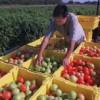 This 4-page fact sheet addresses the effect of phosphorus rate on tomato and green bean yield and growth in high pH soils and discusses their relationship to both nutrition and fertilizer management. Written by Kelly T. Morgan and Kamal Mahmoud, and published by the UF Department of Soil and Water Science, December 2013.
This 4-page fact sheet addresses the effect of phosphorus rate on tomato and green bean yield and growth in high pH soils and discusses their relationship to both nutrition and fertilizer management. Written by Kelly T. Morgan and Kamal Mahmoud, and published by the UF Department of Soil and Water Science, December 2013.
http://edis.ifas.ufl.edu/ss611
Tag: Department of Soil and Water Sciences
Effect of Reduced Soil pH with Sulfur on Available Soil Phosphorus in High pH Sandy Soils of South Florida
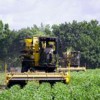 This 3-page fact sheet addresses the effect of moderating soil pH by using sulfur amendments in high pH soils and discusses their relationship to both nutrition and fertilizer management. Written by Kelly T. Morgan and Kamal Mahmoud, and published by the UF Department of Soil and Water Science, December 2013.
This 3-page fact sheet addresses the effect of moderating soil pH by using sulfur amendments in high pH soils and discusses their relationship to both nutrition and fertilizer management. Written by Kelly T. Morgan and Kamal Mahmoud, and published by the UF Department of Soil and Water Science, December 2013.
http://edis.ifas.ufl.edu/ss612
How to Calculate a Partial Nitrogen Mass Budget for Potato
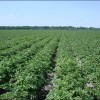 This 6-page fact sheet provides information on the importance of nitrogen budgets for potato cultivation and discusses the steps in preparing the budget. It allows growers to understand the inputs, cycling, and exports of nutrients within and away from the farm, develop a nutrient budget, and analyze best management practices (BMPs) for their farm. The results will be increased N fertilizer use efficiency, increased environmental protection, and reduced economic losses associated with potato cultivation. This document will also aid county agents, environmental management advisors, and government agency staff members who help farmers improve and implement nutrient BMPs to protect water quality. Written by Rishi Prasad and George Hochmuth, and published by the UF Department of Soil and Water Science, December 2013.
This 6-page fact sheet provides information on the importance of nitrogen budgets for potato cultivation and discusses the steps in preparing the budget. It allows growers to understand the inputs, cycling, and exports of nutrients within and away from the farm, develop a nutrient budget, and analyze best management practices (BMPs) for their farm. The results will be increased N fertilizer use efficiency, increased environmental protection, and reduced economic losses associated with potato cultivation. This document will also aid county agents, environmental management advisors, and government agency staff members who help farmers improve and implement nutrient BMPs to protect water quality. Written by Rishi Prasad and George Hochmuth, and published by the UF Department of Soil and Water Science, December 2013.
http://edis.ifas.ufl.edu/ss614
Soil Testing Information Sheets
Use these forms to send samples to the UF/IFAS Extension Soil Testing Laboratory
- Commercial Sod Test Form
- Container Media Test Form
- Landscape and Vegetable Garden Test Form
- Livestock Waste Testing Form
- Nutrient Testing Form for Bahia Pastures
- Phosphorus Index Test Form
- Pine Nursery Soil Test Form
- Plant Tissue Test Form
- Producer Citrus Test Form
- Producer Soil Test Form
- Water Test Form
http://edis.ifas.ufl.edu/topic_soil_testing_information_sheets
Hojas de Informacion de Analisis de Suelos
Llena estas formas para enviar las muestras al UF/IFAS Laboratorio de Servicios Analíticos Laboratorio de Extensión de Análisis de Suelos
- Análisis de Agua
- Análisis de Estiércol
- Análisis de Medios de Macetas
- Análisis de Nutrientes para Pastos de Bahía
- Análisis de Suelo para Césped Comercial
- Análisis de Suelo de Jardines y Huertos
- Análisis de Suelo de Pinos
- Análisis de Suelo para Productores
- Análisis de Tejido Vegetal
- Análisis para Productor de Cítricos
- Índice de Fósforo
http://edis.ifas.ufl.edu/topic_hojas_de_informacion_de_analisis_de_suelos
Conducting a Blue Dye Demonstration to Teach Irrigation and Nutrient Management Principles in a Residential Landscape
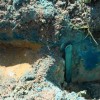 This publication discusses the “blue dye” test, which is one way that Extension professionals can show homeowners how water and nutrients move through the soil following irrigation. The information should be useful for county agents to demonstrate basic irrigation and nitrogen management practices and their effects on nitrate-nitrogen (N) leaching. This 4-page fact sheet was written by George Hochmuth, Laurie Trenholm, Esen Momol, Don Rainey, Claire Lewis, and Brian Niemann, and published by the UF Department of Soil and Water Science, November 2013.
This publication discusses the “blue dye” test, which is one way that Extension professionals can show homeowners how water and nutrients move through the soil following irrigation. The information should be useful for county agents to demonstrate basic irrigation and nitrogen management practices and their effects on nitrate-nitrogen (N) leaching. This 4-page fact sheet was written by George Hochmuth, Laurie Trenholm, Esen Momol, Don Rainey, Claire Lewis, and Brian Niemann, and published by the UF Department of Soil and Water Science, November 2013.
http://edis.ifas.ufl.edu/ss594
The Role of Soil Management in Minimizing Water and Nutrient Losses from the Urban Landscape
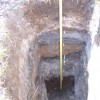 Soil is the most important building block of a healthy, attractive landscape, serving many important physical, chemical, and biological functions. Soil provides a physical substrate for plant support and holds nutrients and water for plant use. It also facilitates groundwater recharge (water moving from surface water to groundwater) and provides long-term storage for organic matter. Soil also provides a habitat for microorganisms that aid in the transformation and availability of nutrients. Soil is an integral part of any ecosystem, but urbanization often changes soils in ways that negatively affect plant development. Soils in urban areas may have reduced water infiltration, resulting in increased runoff and increased potential for nutrient losses. Homeowners in urban areas often overcompensate for poor planting conditions by applying inappropriate amounts of fertilizer and water. These practices eventually lead to nutrient losses through stormwater runoff or soil leaching, and these lost nutrients negatively impact groundwater and ecosystems in nearby springs, streams, and water bodies. This 6-page fact sheet was written by George Hochmuth, Laurie Trenholm, Esen Momol, Don Rainey, Claire Lewis, and Brian Niemann, and published by the UF Department of Soil and Water Science, November 2013.
Soil is the most important building block of a healthy, attractive landscape, serving many important physical, chemical, and biological functions. Soil provides a physical substrate for plant support and holds nutrients and water for plant use. It also facilitates groundwater recharge (water moving from surface water to groundwater) and provides long-term storage for organic matter. Soil also provides a habitat for microorganisms that aid in the transformation and availability of nutrients. Soil is an integral part of any ecosystem, but urbanization often changes soils in ways that negatively affect plant development. Soils in urban areas may have reduced water infiltration, resulting in increased runoff and increased potential for nutrient losses. Homeowners in urban areas often overcompensate for poor planting conditions by applying inappropriate amounts of fertilizer and water. These practices eventually lead to nutrient losses through stormwater runoff or soil leaching, and these lost nutrients negatively impact groundwater and ecosystems in nearby springs, streams, and water bodies. This 6-page fact sheet was written by George Hochmuth, Laurie Trenholm, Esen Momol, Don Rainey, Claire Lewis, and Brian Niemann, and published by the UF Department of Soil and Water Science, November 2013.
http://edis.ifas.ufl.edu/ss593
Maximizing the Benefits of Reclaimed Water for Irrigating the Landscape and Protecting the Environment
 Reclaimed water is water that has been treated in municipal wastewater facilities and is safe to use for designated purposes, including residential landscape irrigation. “Water reuse” is the term used to describe the beneficial application of reclaimed water. Approximately 663 million gallons of reclaimed water are used daily in Florida. Florida is a national leader in using reclaimed water, and in 2006 Florida’s reuse program received the first U.S. Environmental Protection Agency Water Efficiency Leader Award. Using reclaimed water in Florida meets a state objective for conserving freshwater supplies, and preserves the water quality of rivers, streams, lakes, and aquifers. This publication discusses the benefits of using reclaimed water to irrigate the landscape and explains how using reclaimed water helps to protect the environment. This 4-page fact sheet was written by George Hochmuth, Laurie Trenholm, Don Rainey, Esen Momol, Claire Lewis, and Brian Niemann, and published by the UF Department of Soil and Water Science, November 2013.
Reclaimed water is water that has been treated in municipal wastewater facilities and is safe to use for designated purposes, including residential landscape irrigation. “Water reuse” is the term used to describe the beneficial application of reclaimed water. Approximately 663 million gallons of reclaimed water are used daily in Florida. Florida is a national leader in using reclaimed water, and in 2006 Florida’s reuse program received the first U.S. Environmental Protection Agency Water Efficiency Leader Award. Using reclaimed water in Florida meets a state objective for conserving freshwater supplies, and preserves the water quality of rivers, streams, lakes, and aquifers. This publication discusses the benefits of using reclaimed water to irrigate the landscape and explains how using reclaimed water helps to protect the environment. This 4-page fact sheet was written by George Hochmuth, Laurie Trenholm, Don Rainey, Esen Momol, Claire Lewis, and Brian Niemann, and published by the UF Department of Soil and Water Science, November 2013.
http://edis.ifas.ufl.edu/ss587
Managing Landscape Irrigation to Avoid Soil and Nutrient Losses
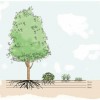 Proper irrigation management is critical to conserve and protect water resources and to properly manage nutrients in the home landscape. How lawns and landscapes are irrigated directly impacts the natural environment, so landscape maintenance professionals and homeowners must adopt environmentally-friendly approaches to irrigation management. After selecting the right plant for the right place, water is the next critical factor to establish and maintain a healthy lawn and landscape. Fertilization is another important component of lawn and landscape maintenance, and irrigation must be applied correctly, especially following fertilization, to minimize potential nutrient losses. This publication supplements other UF/IFAS Extension publications that also include information on the role of soil and the root zone in irrigation management. This publication is designed to help UF/IFAS Extension county agents prepare materials to directly address nutrient losses from lawns and landscapes caused by inadequate irrigation management practices.This 6-page fact sheet was written by George Hochmuth, Laurie Trenholm, Don Rainey, Esen Momol, Claire Lewis, and Brian Niemann, and published by the UF Department of Soil and Water Science, October 2013.
Proper irrigation management is critical to conserve and protect water resources and to properly manage nutrients in the home landscape. How lawns and landscapes are irrigated directly impacts the natural environment, so landscape maintenance professionals and homeowners must adopt environmentally-friendly approaches to irrigation management. After selecting the right plant for the right place, water is the next critical factor to establish and maintain a healthy lawn and landscape. Fertilization is another important component of lawn and landscape maintenance, and irrigation must be applied correctly, especially following fertilization, to minimize potential nutrient losses. This publication supplements other UF/IFAS Extension publications that also include information on the role of soil and the root zone in irrigation management. This publication is designed to help UF/IFAS Extension county agents prepare materials to directly address nutrient losses from lawns and landscapes caused by inadequate irrigation management practices.This 6-page fact sheet was written by George Hochmuth, Laurie Trenholm, Don Rainey, Esen Momol, Claire Lewis, and Brian Niemann, and published by the UF Department of Soil and Water Science, October 2013.
http://edis.ifas.ufl.edu/ss586
Using Reclaimed Water to Irrigate Turfgrass: Lessons Learned from Research with Phosphorus
 Municipal wastes are treated at a wastewater treatment facility to produce biosolids and reclaimed water. Reclaimed water treated by filtration and chlorination is safe to use for designated purposes, such as residential landscape irrigation. Florida began using reclaimed water in 1966, and it is a leading state for using reclaimed water. Approximately 660 million gallons of reclaimed water are used every day in Florida, and the state encourages using reclaimed water as an alternative water source to reduce the pressure on potable water supplies. This 3-page fact sheet summarizes the results of a recent research project and provides research-based information for improving nutrient and water management with reclaimed water irrigation of turfgrass. Written by George Hochmuth, Jinghua Fan, Jason Kruse, and Jerry Sartain, and published by the UF Department of Soil and Water Science, October 2013.
Municipal wastes are treated at a wastewater treatment facility to produce biosolids and reclaimed water. Reclaimed water treated by filtration and chlorination is safe to use for designated purposes, such as residential landscape irrigation. Florida began using reclaimed water in 1966, and it is a leading state for using reclaimed water. Approximately 660 million gallons of reclaimed water are used every day in Florida, and the state encourages using reclaimed water as an alternative water source to reduce the pressure on potable water supplies. This 3-page fact sheet summarizes the results of a recent research project and provides research-based information for improving nutrient and water management with reclaimed water irrigation of turfgrass. Written by George Hochmuth, Jinghua Fan, Jason Kruse, and Jerry Sartain, and published by the UF Department of Soil and Water Science, October 2013.
http://edis.ifas.ufl.edu/ss592
Using Reclaimed Water to Irrigate Turfgrass: Lessons Learned from Research with Nitrogen
 Municipal wastes are treated at a wastewater treatment facility to produce biosolids and reclaimed water. Reclaimed water treated by filtration and chlorination is safe to use for designated purposes, such as residential landscape irrigation. Florida began using reclaimed water in 1966, and it is a leading state for using reclaimed water. Approximately 660 million gallons of reclaimed water are used every day in Florida, and the state encourages using reclaimed water as an alternative water source to reduce the pressure on potable water supplies. This 5-page fact sheet summarizes the results of a recent research project and provides research-based information for improving nutrient and water management with reclaimed water irrigation of turfgrass. Written by George Hochmuth, Jinghua Fan, Jason Kruse, and Jerry Sartain, and published by the UF Department of Soil and Water Science, October 2013.
Municipal wastes are treated at a wastewater treatment facility to produce biosolids and reclaimed water. Reclaimed water treated by filtration and chlorination is safe to use for designated purposes, such as residential landscape irrigation. Florida began using reclaimed water in 1966, and it is a leading state for using reclaimed water. Approximately 660 million gallons of reclaimed water are used every day in Florida, and the state encourages using reclaimed water as an alternative water source to reduce the pressure on potable water supplies. This 5-page fact sheet summarizes the results of a recent research project and provides research-based information for improving nutrient and water management with reclaimed water irrigation of turfgrass. Written by George Hochmuth, Jinghua Fan, Jason Kruse, and Jerry Sartain, and published by the UF Department of Soil and Water Science, October 2013.
http://edis.ifas.ufl.edu/ss591
Nitrogen Cycling and Management for Romaine and Crisphead Lettuce Grown on Organic Soils
 Lettuce has rapid growth and reaches harvest in 60–70 days in South Florida. This leads to high demands for nitrogen fertilization during the short growing season. A good N fertilization scheme should reduce costs, conserve natural resources, and minimize negative environmental impacts. The keys to using fertilizer efficiently are understanding the crop nutrient requirements to predict fertilizer needs and management as well as knowing the appropriate amounts to apply. Lettuce growers also need to know the nutritional status of the crop through soil and plant tissue testing. This 4-page fact sheet was written by Luis Santos, Alan L. Wright, Yigang Luo, Huangjun Lu, and D. Calvin Odero, and published by the UF Department of Soil and Water Science, September 2013.
Lettuce has rapid growth and reaches harvest in 60–70 days in South Florida. This leads to high demands for nitrogen fertilization during the short growing season. A good N fertilization scheme should reduce costs, conserve natural resources, and minimize negative environmental impacts. The keys to using fertilizer efficiently are understanding the crop nutrient requirements to predict fertilizer needs and management as well as knowing the appropriate amounts to apply. Lettuce growers also need to know the nutritional status of the crop through soil and plant tissue testing. This 4-page fact sheet was written by Luis Santos, Alan L. Wright, Yigang Luo, Huangjun Lu, and D. Calvin Odero, and published by the UF Department of Soil and Water Science, September 2013.
http://edis.ifas.ufl.edu/ss588
Nitrogen Cycling and Management for Romaine and Crisphead Lettuce Grown on Organic Soils
 Lettuce reaches harvest in 60–70 days in South Florida. This short growing season leads to high demands for nitrogen fertilization to maintain adequate plant-available N concentrations in the soil. Growers need to supply the required amounts of N to obtain high yields. Lettuce growers also need to know the nutritional status of the crop through soil and plant tissue testing. This 4-page fact sheet was written by Luis Santos, Alan L. Wright, Yigang Luo, Huangjun Lu, and D. Calvin Odero, and published by the UF Department of Soil and Water Science, September 2013.
Lettuce reaches harvest in 60–70 days in South Florida. This short growing season leads to high demands for nitrogen fertilization to maintain adequate plant-available N concentrations in the soil. Growers need to supply the required amounts of N to obtain high yields. Lettuce growers also need to know the nutritional status of the crop through soil and plant tissue testing. This 4-page fact sheet was written by Luis Santos, Alan L. Wright, Yigang Luo, Huangjun Lu, and D. Calvin Odero, and published by the UF Department of Soil and Water Science, September 2013.
http://edis.ifas.ufl.edu/ss588
Silicon Effects on Resistance of St. Augustinegrass to Southern Chinch Bugs and Plant Disease
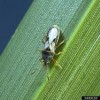 Silicon (Si) is the second most common element on earth, but it is not considered an essential element for plant growth. However, a growing body of evidence has shown that Si can enhance plant resistance to insect pests. This 5-page fact sheet reports the results of a study to determine if silicon applications to St. Augustinegrass varieties increase the silicon in the plants and how this increased silicon affects development and survival of southern chinch bugs as well as development of plant diseases. Written by Alan L. Wright, Ron Cherry, Huangjun Lu, and Pamela Roberts, and published by the UF Department of Soil and Water Science, September 2013.
Silicon (Si) is the second most common element on earth, but it is not considered an essential element for plant growth. However, a growing body of evidence has shown that Si can enhance plant resistance to insect pests. This 5-page fact sheet reports the results of a study to determine if silicon applications to St. Augustinegrass varieties increase the silicon in the plants and how this increased silicon affects development and survival of southern chinch bugs as well as development of plant diseases. Written by Alan L. Wright, Ron Cherry, Huangjun Lu, and Pamela Roberts, and published by the UF Department of Soil and Water Science, September 2013.
http://edis.ifas.ufl.edu/ss589
An Introduction to Biochars and Their Uses in Agriculture
 Biochar, also known as black carbon, is a product derived from organic materials rich in carbon and is found in soils in very stable solid forms, often as deposits. In recent years, considerable research has focused on biochar, its nature, and its properties to explore its potential benefits and negative impacts, particularly for applying to agricultural fields as amendments. This publication provides a general description of biochar, as well as technical details, benefits, and disadvantages of biochar for agricultural and environmental uses. This 4-page fact sheet was written by Rao Mylavarapu, Vimala Nair, and Kelly Morgan, and published by the UF Department of Soil and Water Science, August 2013.
Biochar, also known as black carbon, is a product derived from organic materials rich in carbon and is found in soils in very stable solid forms, often as deposits. In recent years, considerable research has focused on biochar, its nature, and its properties to explore its potential benefits and negative impacts, particularly for applying to agricultural fields as amendments. This publication provides a general description of biochar, as well as technical details, benefits, and disadvantages of biochar for agricultural and environmental uses. This 4-page fact sheet was written by Rao Mylavarapu, Vimala Nair, and Kelly Morgan, and published by the UF Department of Soil and Water Science, August 2013.
http://edis.ifas.ufl.edu/ss585
Calcium (Ca) and Sulfur (S) for Citrus Trees
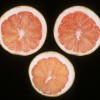 Calcium and sulfur are sometimes called secondary nutrients. This term does not mean that these nutrients play a secondary role in citrus plant growth and development. Ca and S are as essential as N, P, K, Mg, and other nutrients for healthy plant growth. An inadequate supply of Ca and/or S can be a major constraint to crop production and quality. This 5-page fact sheet was written by Mongi Zekri and Tom Obreza, and published by the UF Department of Soil and Water Science, July 2013.
Calcium and sulfur are sometimes called secondary nutrients. This term does not mean that these nutrients play a secondary role in citrus plant growth and development. Ca and S are as essential as N, P, K, Mg, and other nutrients for healthy plant growth. An inadequate supply of Ca and/or S can be a major constraint to crop production and quality. This 5-page fact sheet was written by Mongi Zekri and Tom Obreza, and published by the UF Department of Soil and Water Science, July 2013.
http://edis.ifas.ufl.edu/ss584
Potassium (K) for Citrus Trees
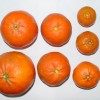 Citrus fruits remove large amounts of K compared to other nutrients. Potassium moves from leaves to fruit and seeds as they develop. Potassium is necessary for several basic physiological functions such as the formation of sugars and starch, synthesis of proteins, normal cell division and growth, and neutralization of organic acids. Potassium is important in fruit formation and enhances fruit size, flavor, and color. This nutrient also helps to reduce the influence that adverse weather conditions (such as drought, cold, and flooding) have on citrus trees. This 4-page fact sheet was written by Mongi Zekri and Tom Obreza, and published by the UF Department of Soil and Water Science, July 2013.
Citrus fruits remove large amounts of K compared to other nutrients. Potassium moves from leaves to fruit and seeds as they develop. Potassium is necessary for several basic physiological functions such as the formation of sugars and starch, synthesis of proteins, normal cell division and growth, and neutralization of organic acids. Potassium is important in fruit formation and enhances fruit size, flavor, and color. This nutrient also helps to reduce the influence that adverse weather conditions (such as drought, cold, and flooding) have on citrus trees. This 4-page fact sheet was written by Mongi Zekri and Tom Obreza, and published by the UF Department of Soil and Water Science, July 2013.
http://edis.ifas.ufl.edu/ss583
Phosphorus (P) for Citrus Trees
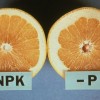 Phosphorus deficiency is not common in Florida citrus groves. If it does occur, it is more difficult to diagnose than nitrogen (N) deficiency or other nutrient element deficiencies. Growth is reduced when P supply is too low. Phosphorus is highly mobile in plants, so when it is deficient, it may move from old leaves to young leaves and other actively growing areas where energy is needed to form seeds and fruit. This 4-page fact sheet was written by Mongi Zekri and Tom Obreza, and published by the UF Department of Soil and Water Science, July 2013.
Phosphorus deficiency is not common in Florida citrus groves. If it does occur, it is more difficult to diagnose than nitrogen (N) deficiency or other nutrient element deficiencies. Growth is reduced when P supply is too low. Phosphorus is highly mobile in plants, so when it is deficient, it may move from old leaves to young leaves and other actively growing areas where energy is needed to form seeds and fruit. This 4-page fact sheet was written by Mongi Zekri and Tom Obreza, and published by the UF Department of Soil and Water Science, July 2013.
http://edis.ifas.ufl.edu/ss581
Magnesium (Mg) for Citrus Trees
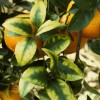 Magnesium deficiency has been a major problem in citrus production. In Florida, Mg deficiency is commonly referred to as “bronzing.” Trees with inadequate Mg may have no symptoms in the spring growth flush, but leaf symptoms develop as the leaves age and the fruit expand and mature in the summer and fall. Magnesium deficiency symptoms occur on mature leaves following the removal of Mg to satisfy fruit requirements. This 4-page fact sheet was written by Mongi Zekri and Tom Obreza, and published by the UF Department of Soil and Water Science, July 2013.
Magnesium deficiency has been a major problem in citrus production. In Florida, Mg deficiency is commonly referred to as “bronzing.” Trees with inadequate Mg may have no symptoms in the spring growth flush, but leaf symptoms develop as the leaves age and the fruit expand and mature in the summer and fall. Magnesium deficiency symptoms occur on mature leaves following the removal of Mg to satisfy fruit requirements. This 4-page fact sheet was written by Mongi Zekri and Tom Obreza, and published by the UF Department of Soil and Water Science, July 2013.
http://edis.ifas.ufl.edu/ss582
Nitrogen (N) for Citrus Trees
 Nitrogen is the key component in mineral fertilizers applied to citrus groves. N has more influence on tree growth, appearance, and fruit production/quality than any other mineral element. Nitrogen affects the absorption and distribution of practically all other elements, and it is particularly important to the tree during flowering and fruit set. This 3-page fact sheet was written by Mongi Zekri and Tom Obreza, and published by the UF Department of Soil and Water Science, July 2013.
Nitrogen is the key component in mineral fertilizers applied to citrus groves. N has more influence on tree growth, appearance, and fruit production/quality than any other mineral element. Nitrogen affects the absorption and distribution of practically all other elements, and it is particularly important to the tree during flowering and fruit set. This 3-page fact sheet was written by Mongi Zekri and Tom Obreza, and published by the UF Department of Soil and Water Science, July 2013.
http://edis.ifas.ufl.edu/ss580